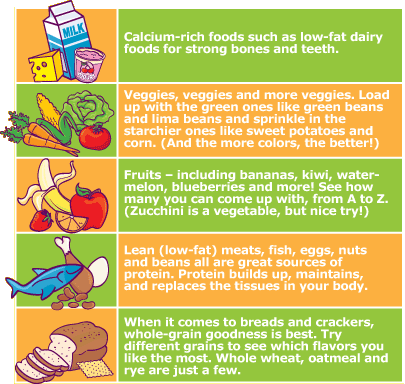“Healthy eating is the key to healthy living.” But healthy eating is not all about staying unrealistically thin or following strict nutrition philosophies. Rather, healthy eating means having healthy food that provides more energy and helps you to adopt a healthy living.
Getting your child to eat healthy and nutritious food is a battle in itself for mothers. Children love eating junk food like burgers, hot dogs, pizzas etc. but fostering good eating habits in your child and keeping mealtimes happy is one of the most important things you need to do as a parent.
For a healthy body, your child’s diet should include all the food groups -from vegetables & fruits to milk, cheese, fish, chicken, meat etc. (in case they are non-vegetarians). So, try to give your child a healthy & a balanced diet and explain the importance of consuming healthy food.
Here are some tips, which may help you in developing healthy eating habits in your child:
Start Early: Help your child establish good eating, exercising and sleeping habits early in life and you won’t have to break bad habits later on. Also, expose your child to a variety of flavours and pair the new flavours with the food that your child already likes.Therefore,make your child eat vegetables at a very young age. This will also help the children develop a taste for healthy food.
Start Slow:Start with the more appealing vegetables like tomatoes, carrots & peas and later work up to the bitter or strongly flavored vegetables like sprouts and leafy greens. Also, encourage your child to eat slowly as this will help detect hunger and fullness better.
Follow a Meal and Snack Schedule: Develop a proper mealtime scheduleas this will help your child learn the structure of eating. Also, ensure the regularity in the timings of meal being served to your child. Therefore, plan for 3 meals and 1 or 2 snacks each day, make sure that the food offered at each meal and snack contributes toward your child’s needs. Also, do not make your child wait for her meal for long, because she may resort to munching snacks until the meal is served to her. Ensure that the routine planned for your child is followed even when she is away from home.

Never let your child skip Breakfast: Always ensure that your child eats her breakfast before stepping out of the home because a healthy breakfast provides the critical nutrients our body needs each day for energy and to manage stress. Also, eating breakfast will turn up the metabolism which will help you manage your child’s weight.
So, prepare a breakfast which is a combination of protein, carbohydrate and healthy fats containing essential fatty acids.
Know your child’s eating preferences: Find out your child’s eating preferences. Make sure you know what kind of food is preferred by your child. Also, try to include healthy ingredients such as vegetables, fruits, oats, milk etc. in the recipes that your child likes.
Shop together: Involve your child in shopping for food. Let her choose the vegetables and fruits of her choice. This would make her admire the colors and shapes of the vegetables. Moreover, while shopping, you will get to know about your child’s preferences and you will be able to teach your child about the nutrition.
Cook together with your child: To increase your child’s interest in vegetables and fruits, the best option is to engage your child in the activities of the kitchen. Involve your child in things such as deciding the menu, the food to be prepared for dinner, washing the vegetables, peeling or cutting them (if the child is old enough) etc. Buy her aprons and let her start out by making her own food.
Let your child use fun gadgets: Every child is a gadget freak. Let your child use a blender, juicer and food processor with proper supervision to make smoothies and other recipes with fruits and vegetables.
Let your child decide her school Tiffin menu: Ensure that your child actively participates in deciding the menu for the school lunch. Let your child be a part of meal planning and preparation.
Introduce a Balanced Meal: Ensure that your child eatswhole grains, fruits and vegetables. Give your child a balanced meal that contains all of the food from the food pyramid. Good eating habits include eating the right food, especially the green vegetables that includes vitamins and antioxidants. Introduce a balanced meal into your child eating schedule.
Make your child fruit friendly – Pack in your child’s daily needs for fresh fruits and make a transition Smoothiewith ice- creams, chocolates or make fruit juice ice popsicles. Also, serve fruits and veggies at each meal, top off cereals with fruits like strawberries and bananas; add grated veggies to the side dishes and soup.
Make food fun for your child: Keep perky and interesting names of the dishes.Get creative in the kitchen and give attractive names to the food you make. This is the easiest thing to make your child eat healthy food.
Make the presentation attractive: Children naturally have a preference for food that they find “enjoyable”. Colour and smell are the most common attributes a child use to judge how appealing a meal is. Therefore, to encourage good eating habits in your child, work on the presentation of the dish. Basically, make the healthy choices more appealing by decorating it. Cut a food into fun and easy shapes with cookie cutters and jazz up the taste of vegetables with tasty dips. Make a face with salad vegetables on a plate (e.g. cucumber slices as eyes, grated carrot hair, cherry tomato nose and mouth). This is fun and will contribute to your child’s healthy diet.
Hide the veggies: In case children do not develop a taste for certain vegetables, you can change the form. Hide the vegetables so well that your child hardly gets to know what she is exactly eating. Also, study various cook books to learn ways to secretly add vegetables and fruits to your child’s diet. Mince them, dip them, top them, puree them or bake them.
Make dinnertime a family time – Start eating meals together as a family when your child is young and slowly it will become a habit. You may not be able to eat together every day but try to have family meals most days of the week and make it enjoyable.
So, make family meals enjoyable:
- Focus on the meal and each other. Turn off the television. Take phone calls or texts later.
- Talk about fun and happy things. Try to make meals a stress-free time.
- Encourage your child to try different food. But, don’t lecture or force your child to eat.
- Have your child help you get ready to eat. Depending on age, make your child help you in setting the table, placing mats or clearing and wiping it later etc.
Make Eating Stress-Free and Relaxing: Provide comfortable child-size chair, easy to hold utensils and cups, to your child. Ensure that your child uses chair that provides him optimum back support. Avoid discussions relating to exams and studies during mealtime.
Make your child eat moderate portions: Use smaller bowls, plates and utensils for your child to eat with. Don’t insist that child will finish all the food on her plate. Let your child know that it’s okay to only eat as much as she wants at that time.
Do not compel your Child to Eat Fast: Let your child eat slowly and chew the food thoroughly before swallowing. This will ensure proper digestion of the food and prevent choking. Moreover, your child will be able to absorb the taste of the food being served. So, do not compel him to eat fast. Also, ensure that your child is not too slow at finishing his meal.
Encourage your child to have at least a bite: Encourage your child to at-least taste the food once and take a bite. Instruct her that she has to take a bite before rejecting something on her plate. This may generate a good taste on the taste buds of your child.
Reward your child with attention and kind words, not food: Do Not Punish, Bribe or Reward your child with food. Rather, show your love with hugs and kisses and don’t use food as a reward. For example, telling your child “no dessert until you finish your vegetables” may make her like the vegetable less and the dessert more.
Discourage eating meals or snacks while watching TV: Ensure that your child eatsonly in designated areas of your home, such as the dining room or kitchen. Eating in front of the TV may make it difficult to pay attention to feelings of fullness and may lead to overeating.
Plan a veggie theme party: Have a talk with your child’s friends’ mothers and plan for a veggie theme party. This will help youeducate your child about healthy diet. So, prepare the vegetarian party menu and try out new dishes from different vegetables. Ensure that you offer a variety of food and entertainment to your child.
Don’t brand good and bad food: Avoid telling your child that a particular food is bad or good. Teach her about the nutritive value of each food. Guide her in choosing food that has higher nutritive value. When you brand some food as bad and some as good, your child tends to go for the food items that are bad when you are not around.
Say No to junk food, but politely: Children are tempted to have mouthwatering junk food every time they go out. Saying “no” to your child at that instance could be imperative, especially when she has strong urge to munch on fast food. So, the best way to refrain your child from junk food is to offer other healthier options that are as much appetizing as his favorite munchies.
Be a Good Role Model: You are the biggest inspiration for your child. Children who see their parents or caregivers buying, cooking and eating healthy food are more motivated to eat healthy food themselves. Therefore, set a positive example in front of your child. To make them eat all sorts of fruits and vegetables, ensure that you consume them as well. This way, you can send a message that good health is important to your family.
Lastly, remember when you introduce new food and eating habits to your child, remember to talk about healthy eating in a positive way and try to make healthy eating for your child as fun and interactive as possible. Keep trying slowly & steadily to shift your child’s focus from junk and fast food to home-cooked healthy food, showing lots of patience and persistence and you will surely succeed. All the Best!












Nice information as healthy eating habits are very beneficial. keep sharing.